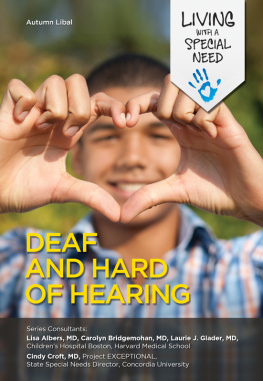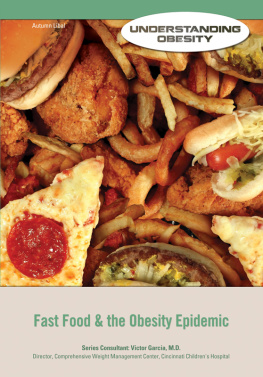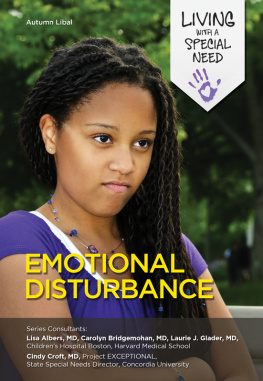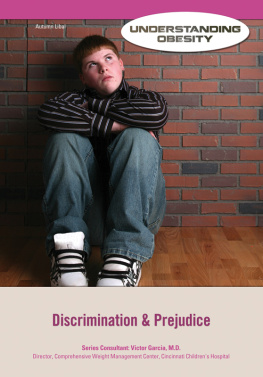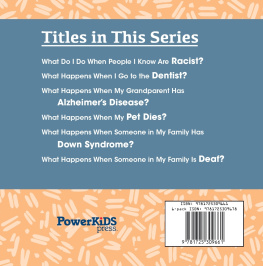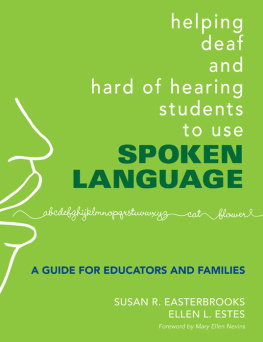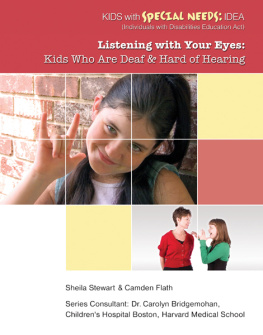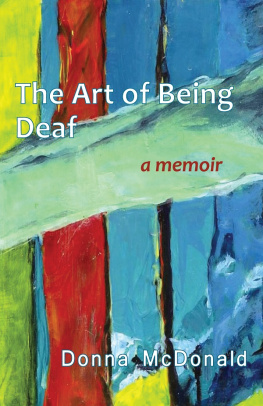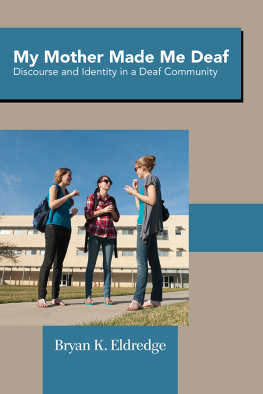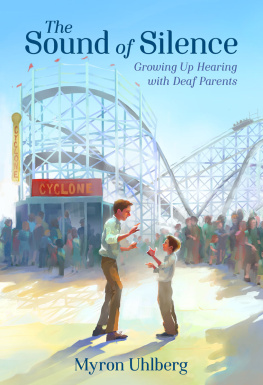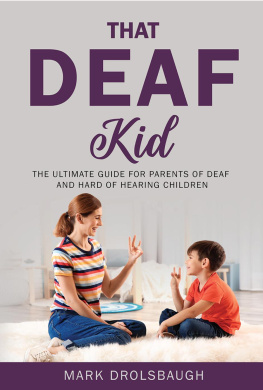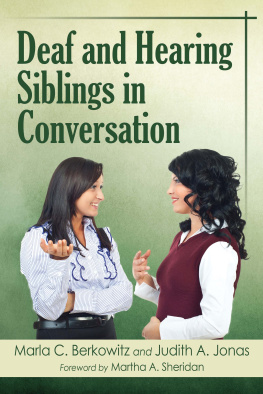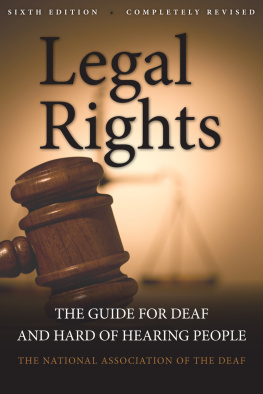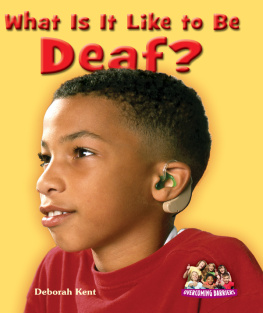Deaf and Hard of Hearing
LIVING WITH A SPECIAL NEED
Attention-Deficit/Hyperactivity Disorder
Autism
Blindness and Vision Impairment
Brain Injury
Chronic Illness
Deaf and Hard of Hearing
Emotional Disturbance
Gender Issues
Intellectual Disabilities
Learning Disabilities
Physical Challenges
Protective Services
Speech Impairment
The Foster Care System
The Juvenile Court System
The Laws That Protect Youth with Special Needs
LIVING WITH A SPECIAL NEED
Deaf and Hard of Hearing
AUTUMN LIBAL
MASON CREST
Special thanks to the Rochester School for the Deaf for their generous help with this book's photos. The author is also deeply grateful to Scott R. Smith, MD, MPH, a deaf person himself as well as a pediatrician who works with deaf and hard-of-hearing children, for his insights and help.
Mason Crest
450 Parkway Drive, Suite D
Broomall, PA 19008
www.masoncrest.com
Copyright 2015 by Mason Crest, an imprint of National Highlights, Inc. All rights reserved. No part of this publication may be reproduced or transmitted in any form or by any means, electronic or mechanical, including photocopying, recording, taping, or any information storage and retrieval system, without permission from the publisher.
Printed and bound in the United States of America.
Series ISBN: 978-1-4222-3027-5
ISBN: 978-1-4222-3033-6
ebook ISBN: 978-1-4222-8818-4
Library of Congress Cataloging-in-Publication Data
Libal, Autumn.
[Ocean inside]
Deaf and hard of hearing / Autumn Libal.
pages cm (Living with a special need)
Audience: 12.
Audience: Grade 7 to 8.
Revision of: Ocean inside. 2004.
Includes index.
ISBN 978-1-4222-3033-6 (hardback) ISBN 978-1-4222-3027-5 (series) ISBN 978-1-4222-8818-4 (ebook) 1. Deaf children-Juvenile literature. I. Title.
HV2392.L52 2015
362.42083dc23
2014010628
Picture credits: Agnostic Preachers Kid: p.. Individuals in PhotoDisc and Photo Alto images are models, and these images are intended for illustrative purposes only.
Each child is unique and wonderful. And some children have differences we call special needs. Special needs can mean many things. Sometimes children will learn differently, or hear with an aid, or read with Braille. A young person may have a hard time communicating or paying attention. A child can be born with a special need, or acquire it by an accident or through a health condition. Sometimes a child will be developing in a typical manner and then become delayed in that development. But whatever problems a child may have with her learning, emotions, behavior, or physical body, she is always a person first. She is not defined by her disability; instead, the disability is just one part of who she is.
Inclusion means that young people with and without special needs are together in the same settings. They learn together in school; they play together in their communities; they all have the same opportunities to belong. Children learn so much from each other. A child with a hearing impairment, for example, can teach another child a new way to communicate using sign language. Someone else who has a physical disability affecting his legs can show his friends how to play wheelchair basketball. Children with and without special needs can teach each other how to appreciate and celebrate their differences. They can also help each other discover how people are more alike than they are different. Understanding and appreciating how we all have similar needs helps us learn empathy and sensitivity.
In this series, you will read about young people with special needs from the unique perspectives of children and adolescents who are experiencing the disability firsthand. Of course, not all children with a particular disability are the same as the characters in the stories. But the stories demonstrate at an emotional level how a special need impacts a child, his family, and his friends. The factual material in each chapter will expand your horizons by adding to your knowledge about a particular disability. The series as a whole will help you understand differences better and appreciate how they make us all stronger and better.
Cindy Croft
Educational Consultant
YOUTH WITH SPECIAL NEEDS provides a unique forum for demystifying a wide variety of childhood medical and developmental disabilities. Written to captivate an adolescent audience, the books bring to life the challenges and triumphs experienced by children with common chronic conditions such as hearing loss, mental retardation, physical differences, and speech difficulties. The topics are addressed frankly through a blend of fiction and fact. Students and teachers alike can move beyond the information provided by accessing the resources offered at the end of each text.
This series is particularly important today as the number of children with special needs is on the rise. Over the last two decades, advances in pediatric medical techniques have allowed children who have chronic illnesses and disabilities to live longer, more functional lives. As a result, these children represent an increasingly visible part of North American population in all aspects of daily life. Students are exposed to peers with special needs in their classrooms, through extracurricular activities, and in the community. Often, young people have misperceptions and unanswered questions about a childs disabilitiesand more important, his or her abilities. Many times, there is no vehicle for talking about these complex issues in a comfortable manner.
This series provides basic information that will leave readers with a deeper understanding of each condition, along with an awareness of some of the associated emotional impacts on affected children, their families, and their peers. It will also encourage further conversation about these issues. Most important, the series promotes a greater comfort for its readers as they live, play, and work side by side with these individuals who have medical and developmental differencesyouth with special needs.
Dr. Lisa Albers, Dr. Carolyn Bridgemohan, Dr. Laurie Glader
Medical Consultants
Words to Understand
audiological: Having to do with ones sense of hearing.
molecules: The smallest particles that elements and compounds can be divided into before their chemical or physical properties change.
amplifies: Makes greater or increases.
malformation: Something that is not formed in the correct way.
audiologist: A doctor or technician who studies hearing and/or treats hearing loss.
Dana sat in the soundproof booth with her baby on her lap. Denzel watched her intently, wide eyes staring from his dark, chubby face. He opened his mouth in a pink, toothless smile, and a bubble welled up between his lips. He lifted a pudgy finger, and the bubble popped at his touch. Squirming with surprised delight, Denzel tugged at his mothers shirt with his moist hand.

